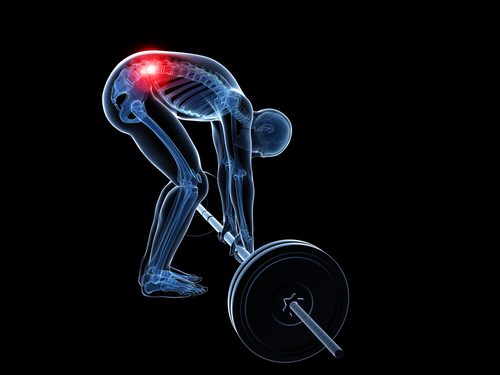 Steer Clear of Back Injuries While You Work Out!
Steer Clear of Back Injuries While You Work Out!
Picture it: you’re in the gym, you’re working hard, you’re getting in the heavy weights, and before you know it…. Something hurts. A lot.
You reach for your back – because, all of a sudden, it’s super difficult to hold yourself upright – and you put your hand on your hip to hold yourself up. You sit, because it feels good, and you wince at the thought of standing, because… well, that doesn’t.
Welcome to the world of training-related back pain.
But you don’t want to enter this world! The world of herniated discs, sciatica, pinched nerves… you don’t want this life. Surgeries, medications that – though necessary – disorient you and can put you out of commission for extended periods of time, extended pain… this is the kind of training pain that is completely avoidable, and I’m going to share with you how.
Back pain is actually quite easy to trigger in training, and it’s unlike any other pain – whereas, with leg pain, you’re using your legs to get from point A to point B and then you sit, you are constantly using your core – especially your spine – from the moment you wake up, to the moment you go to sleep. It doesn’t get any breaks. Protecting that throughout the day and during training makes sense.
The first point is posture. When you train your upper body and come out of the gym feeling sore, most people’s first inclination is to slouch. You’re tired, you don’t want to sit up.
Sit up. Sit up.
 Mindfully sitting with upright posture helps protect your spine – post-training slouching always results in pain and, eventually, damage because the muscle we’re building in our training will grow in a way to, eventually, permanently force our backs in that slouched position, eventually making upright posture painful.
Mindfully sitting with upright posture helps protect your spine – post-training slouching always results in pain and, eventually, damage because the muscle we’re building in our training will grow in a way to, eventually, permanently force our backs in that slouched position, eventually making upright posture painful.
If you stand up, and think of your pelvic bone – the bone in your hips, beneath your belly button and right where your legs and glutes meet – as a bowl, arch your back. Consider this motion “tipping your bowl forward,” as if you’re spilling water out of the side. Now, if you think of tipping your bowl upright to prevent from spilling out any water, this is proper posture. Pelvis tilted upright, shoulders and spine in a perfect line above your hips, with no curve in the back and no arch – this is perfect posture. This is what you need – it is your best friend.
My second tip is to take that perfect posture and translate that into your training. Perfect your form – it is essential to preventing back pain. For instance, when you do overhead presses, your back should be in perfect alignment and, if it isn’t, consider lowering the weights. Weight machines that restrict your back or “hold you up” during exercises actually hinder – and, under the right circumstances, harm – your back and can cause you to develop everything from shoulder damage to slipped discs from the unnecessary pressure on your back. In other words, the pec deck? Skip that.
But, then how do I train my back? Free weight exercises, calisthenics, and flexibility training are your best bet. Flexibility training – consistent stretching – allows your body to adapt to more kinds of movement, and loosens up the muscles and connective tissues around the back, which better enables it to protect it. Calisthenics provides exercise that is completely equipment free, forcing you to focus on how you’re moving, how it feels, and making it feel better – which translates to you performing better and improving your quality of life. And, lastly, free weight exercises can help you home in on developing muscle groups without restricting or applying unnecessary pressure to your back.
Keep these tips in mind when you create your next training program, and – without a doubt, I promise you – your quality of life will improve, your back will grow proportionately healthy and strong, and – as I always say – your body will thank you for it!
Source: www.ebony.com; Erika Nicole Kendall; August 20, 2014.








